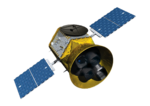Astronomy:Explorer 55
| Mission type | Earth science |
|---|---|
| Operator | NASA |
| COSPAR ID | 1975-107A[1] |
| SATCAT no. | 8440[2] |
| Spacecraft properties | |
| Manufacturer | RCA Astro |
| Launch mass | 735 kg (1,620 lb) |
| Start of mission | |
| Launch date | 20 November 1975, 02:06:48 UTC[3] |
| Rocket | Delta 2910 604/D117[4] |
| Launch site | Cape Canaveral Air Force Station LC-17B |
| End of mission | |
| Decay date | 10 June 1981 |
| Orbital parameters | |
| Reference system | Geocentric |
| Regime | Low Earth |
| Eccentricity | 0.17774[1] |
| Perigee altitude | 156 km (97 mi)[1] |
| Apogee altitude | 2,983 km (1,854 mi)[1] |
| Inclination | 19.7°[1] |
| Period | 117.29 minutes[1] |
| Epoch | 20 November 1975[1] |
Explorers Program | |
Explorer 55, also called as AE-E (Atmospheric Explorer E), was a NASA scientific satellite belonging to series Atmosphere Explorer, being launched on November 20, 1975 from Cape Canaveral Air Force Station board a Delta 2910 rocket.
Characteristics
The purpose of the Explorer 55 mission was to investigate the chemical processes and energy transfer mechanisms that control the structure and behavior of the earth's atmosphere and ionosphere in the region of high absorption of solar energy at low and equatorial latitudes. The simultaneous sampling at higher latitudes was carried out by the Explorer 54 spacecraft until its failure on January 29, 1976, and then by Explorer 51, until it reentered on December 12, 1978. The same type of spacecraft as Explorer 51 was used, and the payload consisted of the same types of instruments except that the low-energy electron and UV nitric oxide experiments were deleted and a backscatter UV spectrometer was added to monitor the ozone content of the atmosphere.
The 2 experiments that were deleted were more appropriate for the high-latitude regions. The perigee swept through more than 6 full latitude cycles and two local time cycles during the first year after launch when the orbit was elliptical and the perigee height was varied between 130 kilometres (81 mi) and 400 kilometres (250 mi). The circularization of the orbit around 390 kilometres (240 mi) was made on November 20, 1976 and the spacecraft was raised to this height whenever it would decay to about 250 kilometres (160 mi). AE-E reentered on June 10, 1981.[1]
References
- ↑ 1.0 1.1 1.2 1.3 1.4 1.5 1.6 1.7 "AE-5". NSSDC Master Catalog. NASA Goddard Space Flight Center. https://nssdc.gsfc.nasa.gov/nmc/spacecraft/display.action?id=1975-107A. Retrieved June 21, 2018.
 This article incorporates text from this source, which is in the public domain.
This article incorporates text from this source, which is in the public domain.
- ↑ n2yo.com (2012). "EXPLORER 55 (AE-E)". http://www.n2yo.com/satellite/?s=8440. Retrieved June 21, 2018.
- ↑ "Jonathan's Space Page". Jonathan McDowell. http://www.planet4589.org/space/log/launchlog.txt. Retrieved 2018-06-21.
- ↑ "Explorer". Encyclopedia Astronautica. Mark Wade. http://www.astronautix.com/e/explorer.html. Retrieved 2018-06-21.


